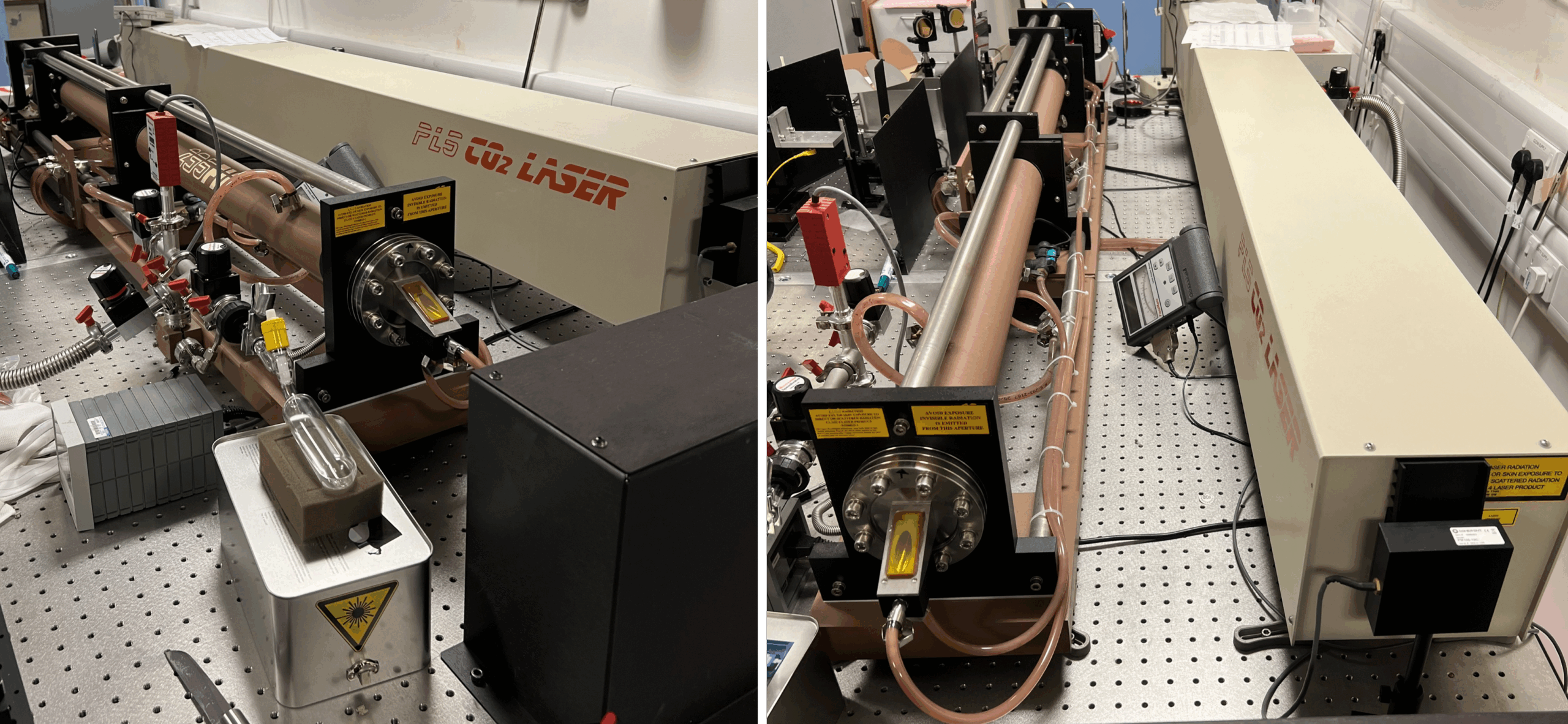The ability to accurately determine the state of polarisation (SoP) in the terahertz (THz) range supports emerging technologies in secure communications, material characterisation, non-destructive testing, and biomedical imaging. Traditional THz polarimeters often rely on rotating components or sequential measurements, which can cause mechanical instabilities and increase acquisition times.
To address these challenges, researchers at the University of Glasgow developed a monolithic metasurface polarimeter (MSP) made from a single layer of silicon micropillars. The MSP’s optical characterisation was carried out using an Edinburgh Instruments FIR-295 laser operating in the far-infrared range. By capturing all polarisation information in one image, the MSP eliminates the need for moving parts, enabling fast, compact, and robust THz polarimetry. The outcomes of this study were published in Optics Letters.
The MSP was illuminated by an FIR-295 (Figure 1) continuous-wave, far-infrared gas laser tuned to 2.52 THz. A PL5 CO2 laser optically pumped the FIR-295, which produced up to 120 mW of output power in a linearly horizontally polarised (H) Gaussian beam with excellent spatial quality and long-term stability. These features were vital in maximising the signal-to-noise ratio and guaranteeing consistent measurements.

Figure 1 Optical images from the experimental setup used by the University of Glasgow researchers showing an Edinburgh Instruments FIR-295 gas laser, optically pumped by the PL5 CO2 laser. Images courtesy of University of Glasgow.
The FIR-295 beam was directed onto the metasurface, which consisted of three interleaved arrays of silicon micropillars arranged in a hexagonal pattern. Transmission through the structure produced three spatially separated intensity spots on the detector. The relative brightness of each spot varied depending on the incident polarisation state, meaning that the polarisation information was directly encoded in the measured intensity distribution (Figure 2).

Figure 2 Schematic of the setup employed for the calibration and SoP measurements. BS: non-polarising beam splitter; PM: power meter; LP: linear polariser; HWR/QWR: Half/Quarter wave retarder. Image used with permission from the authors.
To calibrate the system, the researchers employed a set of well-defined polarisation states: horizontal (H), vertical (V), diagonal (D), anti-diagonal (A), right-handed circular (R), and left-handed circular (L). By recording the corresponding spot intensities for these input states, they established a reference matrix (Figure 3). This calibration allowed for the subsequent recovery of the full set of Stokes parameters (S₁, S₂, S₃) for any arbitrary polarisation state from a single captured image, without the need for moving components or sequential measurements.

Figure 3 Calibration measurements of the MSP with incident light of the six degenerate SoPs: (a) H, (b) V, (c) D, (d) A, (e) R, and (f) L. Each image displays the detected intensity at the focal plane f = 82 mm behind the metasurface. In each image, the focal spots resulting from the six phase functions are labelled with their respective SoP, with a designed off-axis displacement ∆xy of 3.88 mm. The intensity distribution among these six focal spots varies with the incident SoP, aligning well with the simulations presented in the paper. Image used with permission by the authors.
The metasurface polarimeter achieved a polarimetric accuracy of 92.1% ± 4.2%, in excellent agreement with finite-difference time-domain simulations. The high optical power and beam quality of the FIR-295 enabled strong detector signals and reduced integration times, making the single-shot polarimetry feasible. This performance marks a step forward in THz metrology: a compact, mechanically stable polarimeter capable of capturing the full polarisation state in real time. The study demonstrates the advantages of combining advanced metasurface optics with a high-performance terahertz (THz) source, such as the FIR-295.
The University of Glasgow team demonstrated that single-shot THz polarimetry is possible using a straightforward, monolithic metasurface in combination with a stable, high-power THz laser. The Edinburgh Instruments FIR-295 was crucial to this achievement, providing the power, stability, and beam quality needed for precise polarisation analysis without moving optics. This method opens the door to compact, reliable, and highly accurate THz polarimetry systems that could advance developments in secure communications, imaging, and materials diagnostics.
The results presented in this Research Highlight were published in Optics Letters, and more details are available at https://doi.org/10.1364/OL.463143.

